This is a continuation of our series on spring bike maintenance. Click here to read Part 1: Washing, Fork Maintenance, and More.
Drivetrain Maintenance

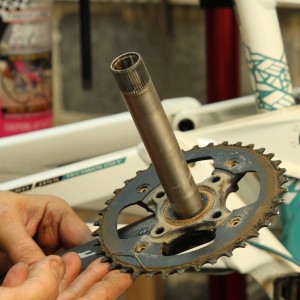


After cleaning your bike and maintaining your fork, it’s time to tackle the drivetrain, frame pivots, and brakes.
Carefully remove the crank arms. Most cranks are self-extracting using an 8mm Allen key. Older models (square taper) may require a crank arm puller. Whichever model you have, remove the arm and get ready to check the condition of the bottom bracket bearings and cups.
Once the arms are off you have a better view of the bottom bracket and the bearing condition. If the bearing looks rusty or feels crunchy, it’s time to start up a list of replacement parts, and bottom bracket bearings or a complete cartridge may just be the first on the list.
Remove the bottom bracket using proper tools (depending on which bottom bracket you have) such as the Park BBT#19 used on this bike. Once that is off you can clean up the threads and individually check each bearing for lube and condition.
Not all bottom brackets let you access the races, but some will allow you to carefully pry a dust shield off. If that is the case, cleaning it up with solvent and re-greasing could be an inexpensive alternative to complete replacement. When reinstalling the bottom bracket or bottom bracket cups, clean then lube the cups to prevent them from galling or seizing up in the future.
The key here, besides adding the correct spacer(s), is to carefully align the cups to prevent cross threading when installing, and to ensure you do not over torque them (follow the manufacturer’s recommendations).
I hold off on the installation of the cranks until I finish the rest of the frame work.
Frame Maintenance

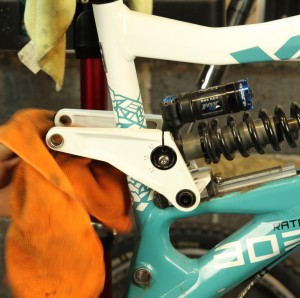

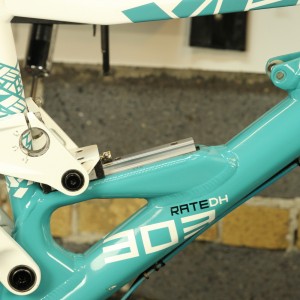
While the frame is nearly naked with just the bottom bracket in place, I can work on the rest of the frame with unrestricted access to the pivots.
Remove the rear derailleur (without disturbing any of the settings) and brake, so that the rear triangle has nothing attached to it.
On this Yeti 303 we had to inspect all the bearings. Start by removing the rear triangle from the frame. With the triangle off you can now feel for any grinding or roughness in the main pivot.
Since this is a downhill bike and has been ridden hard in both dusty and muddy conditions, I knew it was necessary to check individual bearings and links. So starting at the top and cleaning things as I went, I worked my way down and started to remove the rest of the linkages and the rear shock.
With each link removed, check individual bearings by spinning them and feeling the smoothness (or lack thereof). I use a small pick and pry the dust shields off to visually check for contamination. Then I add a high-quality grease by injecting it into each bearing, and seal it up again. After each pivot I re-torque it to factory spec.
Apply a side load to check for play (no play and you’re good; if there is play then you need to replace bearings).
In the event that one or two bearings are beyond your help, start a list of what is bad, call up your local LBS (or manufacturer), and get price quotes on new bearings. Replacing a bearing takes specialized pullers, which is a bit beyond this article. It’s best to leave that to the experts.
After all the bearings were done, we inspected the 303’s slider arrangement for wear and play.
After a cleaning and some fresh grease we’re ready to re-install the rear shock. Before the shock is bolted down, check the DU bushing and hardware for wear. If there is any, now is the time to get it replaced.

Torque down the shock and install the rear derailleur, but not the cables or rear brakes.
Brake Maintenance
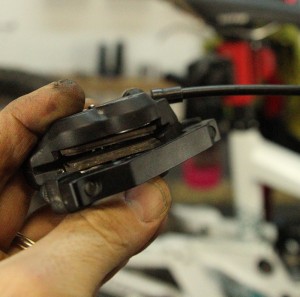

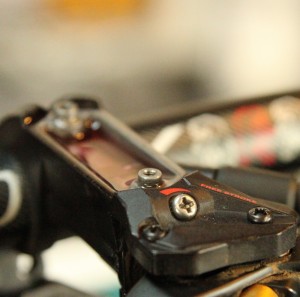
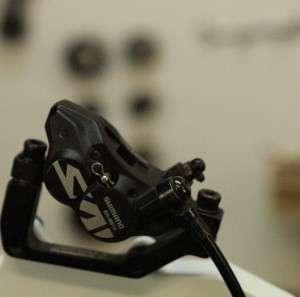
First, find the plastic hardware that came with your brakes (the pad spreaders that most people throw away). With the pads still on the brake, cycle the brakes a few times to check for operation. Note the amount that each piston in your caliper moves with each stroke. Both sides of pistons should move the same distance per stroke of the lever (approximately 1.5mm). If for some reason there is uneven movement you need to cycle each piston to free itself.
Start off by removing the brake pads and then cleaning the caliper with bike wash, removing any trace of dust and debris. I then (with the aid of a friend) cycle the brake lever while holding back one side of the caliper with a wide screw driver (be careful not to cycle too much as to push the piston right out of the caliper). Then push the extended piston back into the caliper body. Do this to each piston, until the pistons moves equally and freely. The purpose of this whole task is to lube the seals of the piston. This is one of the most essential service tasks a rider can do to his bike to ensure good braking. After talking with many people from Avid, Hayes, and Formula, they all agree that this is something that people forget to do.
Once the calipers are free, install a new set of pads. In the example here we inspected the pads, which had a bit more than 1mm left on them, so we cleaned them up with 400grt sand paper and tossed them back on (a few more runs are expected from these, but not a whole season). Having the calipers removed with the adapter makes for an easy installation when we are ready to replace the bar.
The key difference with Shimano brakes is the use of Shimano’s brake fluid, which is NOT compatible with other brands. Shimano uses mineral oil in their systems.To bleed the brakes on this bike, it is best to first move the levers on the bar so they are parallel with the ground, then remove the reservoir caps with a Phillips screwdriver. Now remove all the oil in the reservoir.
Prepare a second syringe with fresh brake fluid and bleed the brakes, as described inthis article. What you’re doing here is basically a reverse bleed which pushes the fluid from the caliper body into the lever reservoir. Once the reservoir is full again, suck out that old stuff, and top it off with new fluid.
Close the bleed port at the caliper, slowly cycle the brake lever, and check the feel of the brakes. You should have a solid feel to the lever. If not, reopen the caliper port and push a bit more fluid through, this time tapping the brake line to ensure that no air bubbles cling inside the brake hose. Close the port off and check again.
Once you’re happy with the brake feel, ensure the reservoir is full and then install the top cap again. Wipe off the brake levers and you’re good. This extra work on the brakes and making sure everything is fresh is essential for good brake operation and modulation.
(See our comprehensive disc brake service article for more info.)
Stay tuned for Part 3: Headset Maintenance, Component Reinstallation, and Final Details.













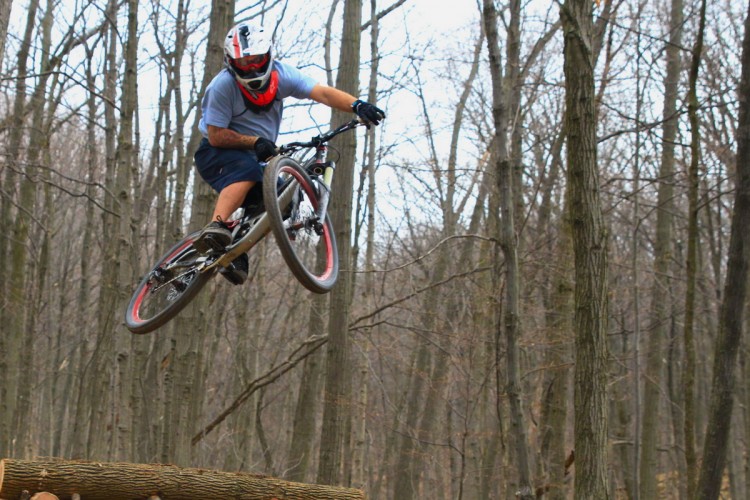






1 Comments
May 25, 2012